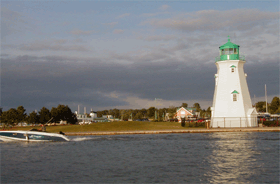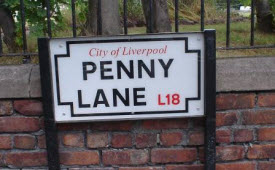
Road Trip! — Ten Songs Inspired by Real Places
Many people are inspired by their favorite songs about places to visit the locations that inspired them. But don’t bother looking for 22 Acacia Avenue or Xanadu on Google Maps — they don’t exist anywhere but in their songwriters’ minds. Elsewhere, however, there are plenty of songs that were inspired by real places. Here are ten of them, should you feel the urge to make a pilgrimage.
(You can also check out this list on my Spotify playlist.)
 Rush drummer and lyricist Neil Peart grew up in Port Dalhousie, Ontario and spent many youthful summers on the village’s most popular beach — Lakeside Park. Peart paid tribute in an atypically nostalgic song on Rush’s third album, 1975’s Caress of Steel.
Rush drummer and lyricist Neil Peart grew up in Port Dalhousie, Ontario and spent many youthful summers on the village’s most popular beach — Lakeside Park. Peart paid tribute in an atypically nostalgic song on Rush’s third album, 1975’s Caress of Steel.
Peart later reminisced about his Lakeside Park experiences in an interview for Traveling Music: “Another important setting in my childhood and early teens was Lakeside Park, in Port Dalhousie. When I was 14 and 15, I worked summers at Lakeside Park as a barker (‘Catch a bubble, prize every time,’ all day and night), and there was music: some of the kids brought transistor radios to work, and the music of that summer of 1966 played up and down the midway. At night, when the midway closed, we gathered around a fire on the beach, singing. Lakeside Park resonated in my life in so many deep ways, especially those fundamental exposures to music that would be forever important. It’s all gone now. All that’s left, apart from memories, is the old merry-go-round.”
Barrytown is a hamlet within the town of Red Hook, in southeast New York state. Steely Dan co-founders Donald Fagen and Walter Becker attended college at Bard College in nearby Annandale-on-Hudson. While there it seems they took note of town’s inhabitants, namely the members of Sun Myung Moon’s Unification Church (“Moonies”), which opened a seminary there in the ’70s (“I can see by what you carry/that you come from Barrytown”). “Barrytown” appeared on Steely Dan’s 1974 LP Pretzel Logic.
The town of Twentynine Palms sits in the desert southeast of California and is home to both Joshua Tree National Park and the Marine Corps Air Ground Combat Center. It’s also the setting for a song from Robert Plant’s 1993 solo LP Fate of Nations. Plant has confirmed that he was inspired to write “29 Palms” while on tour with Canadian singer Alannah Myles in California in 1990, but has stopped short of confirming rumors that the two were a romantic item.
There are two important things to know about “Elvira.” The first is that although the Oak Ridge Boys had a hit with the song in 1981 (#1 U.S. Hot Country, #5 U.S. Hot 100), it was actually a cover of a song written by Dallas Frazier fifteen years earlier. The second is that Elvira refers not to a woman but to a street in East Nashville. The story goes that Frazier was the passenger in car driven by publisher Ray Baker, and he found inspiration when he saw the street sign for Elvira Ave. (off of US 31E, aka Gallatin Road or Gallatin Pike). However, there are no contemporary accounts of the road being “on fira” that day.

Mike Mills, R.E.M. bassist and co-founder, wrote this as a literal plea to his one-time girlfriend, Ingrid Schorr, to not return to her parents’ home in Rockville, Maryland. Schorr’s recounting of the song’s inspiration goes like this — “In the spring of 1980 I was at college in Athens, Georgia. My once-good grades had given way to behavior that my parents were starting to get wind of, and they instructed me to come back home to Maryland for the summer. I didn’t want to go. Everything in Athens was so… fresh and exciting. I had just started taking part in the innocent decadence that would sustain the scene for the next several years. And I was just beginning a romance with Mike Mills, the bass player in the weeks-old R.E.M. A few weeks before the end of spring quarter he said to me—we were at Tyrone’s, the local rock club, standing between the Rolling Stones pinball machine and the Space Invaders game, playing neither—’I finally meet a girl I like and she’s got to go back to Rockville.'”
It would be easy to assume that “Devil’s Island,” from Megadeth’s 1986 album Peace Sells… but Who’s Buying?, is some sort of Satanic Club Med. It was in fact the site of an infamous French penal (and former leper) colony that operated from 1852 until 1952. The island lies roughly six nautical miles off the coast of French Guiana in South America, and housed thieves, murderers, and political prisoners for a century. More than 80,000 prisoners were sent to the island, many of whom were never heard from again. The island’s most famous resident was Alfred Dreyfus, who was convicted of treason and shipped there in 1895. Dreyfus was pardoned and released in 1899, and through him the French public learned of the horrors of Devil’s Island.
 The lyrics to “Penny Lane,” whimsical and nostalgic as they are, sure seem the stuff of fantasy. In fact there is a real Penny Lane in Liverpool, where the Fab Four were born. Paul McCartney (who wrote the song) and John Lennon often met at Penny Lane junction in the Mossley Hill area to catch a bus into the center of Liverpool.
The lyrics to “Penny Lane,” whimsical and nostalgic as they are, sure seem the stuff of fantasy. In fact there is a real Penny Lane in Liverpool, where the Fab Four were born. Paul McCartney (who wrote the song) and John Lennon often met at Penny Lane junction in the Mossley Hill area to catch a bus into the center of Liverpool.
In the ’50s and ’60s this was a significant bus terminus for several routes, and buses with “Penny Lane” displayed were common throughout Liverpool. The street itself is named after James Penny, an 18th century slave trader, and is an important landmark for Beatles fans — some of whom made an unfortunate habit of stealing signs bearing the road’s name.
While the term “dead man’s curve” has been applied to any number of dangerous turns, Jan & Dean’s Top 10 hit from 1964 refers to a drag race held on one in particular. The race (between a Corvette Sting Ray and a Jaguar XKE) starts at Sunset and Vine and heads west along West Sunset Blvd. for about seven miles, passing North La Brea Ave., North Crescent Heights Blvd., and North Doheny Dr. along the way. The North Whittier Drive curve, an almost ninety-degree right turn traveling west on Sunset Boulevard just past North Whittier Drive, is the dead man’s curve that results in the fiery crash heard in the song.
As recounted by Doors drummer John Densmore in his book Riders on the Storm, the “Soul Kitchen” was a small soul food restaurant called Olivia’s. It was located at 2615 Main Street, at the intersection of Ocean Park Blvd. and Main in Santa Monica, and it was run by — you guessed it — Olivia, who cared not for late-dining patrons. Jim Morrison, who wrote the lyrics to the song, ate there often and had to be shooed out at closing time, inspiring him to write lines like “Well the clock says it’s time to close now/I know I have to go now/I’d really like to stay here all night… Let me sleep all night in your soul kitchen/warm my mind near your gentle stove/turn me out and I’ll wander, baby/stumbling in the neon grove.”
 This is one of Bird’s greatest compositions, and certainly one of my favorites, but has a rather sad background. Parker, whose drug habit started when he was a teenager, dogged him throughout his all-too-brief life. Heroin was Parker’s drug of choice, but booze would do as well.
This is one of Bird’s greatest compositions, and certainly one of my favorites, but has a rather sad background. Parker, whose drug habit started when he was a teenager, dogged him throughout his all-too-brief life. Heroin was Parker’s drug of choice, but booze would do as well.
In 1946 an inebriated Parker set fire to the mattress in his California hotel room and ran into the lobby wearing nothing but his socks. He was arrested and sentenced to stay in Camarillo State Mental Hospital. When he emerged from the institution after six months he was (briefly) clean and wrote the song that bears the hospital’s name.
Camarillo State Hospital closed in 1997 and the buildings are now part of California State University, Channel Islands.
Related articles
- Why the Hell Should I Like… Rush? (popblerd.com)
- Artist Spotlight: The Oak Ridge Boys (roughstock.com)
- All That Glitters: Led Zeppelin – “The Battle of Evermore” (Sound Affects) (popmatters.com)

People found this post by searching for:
- "camarillo state mental hospital"